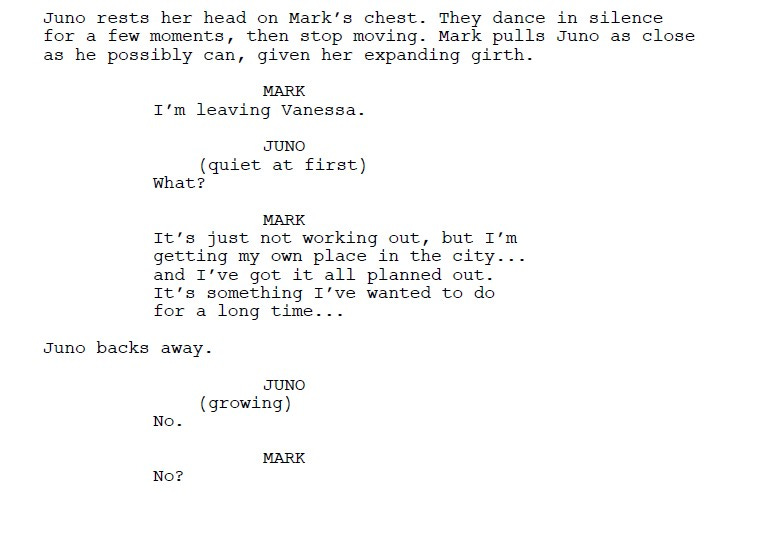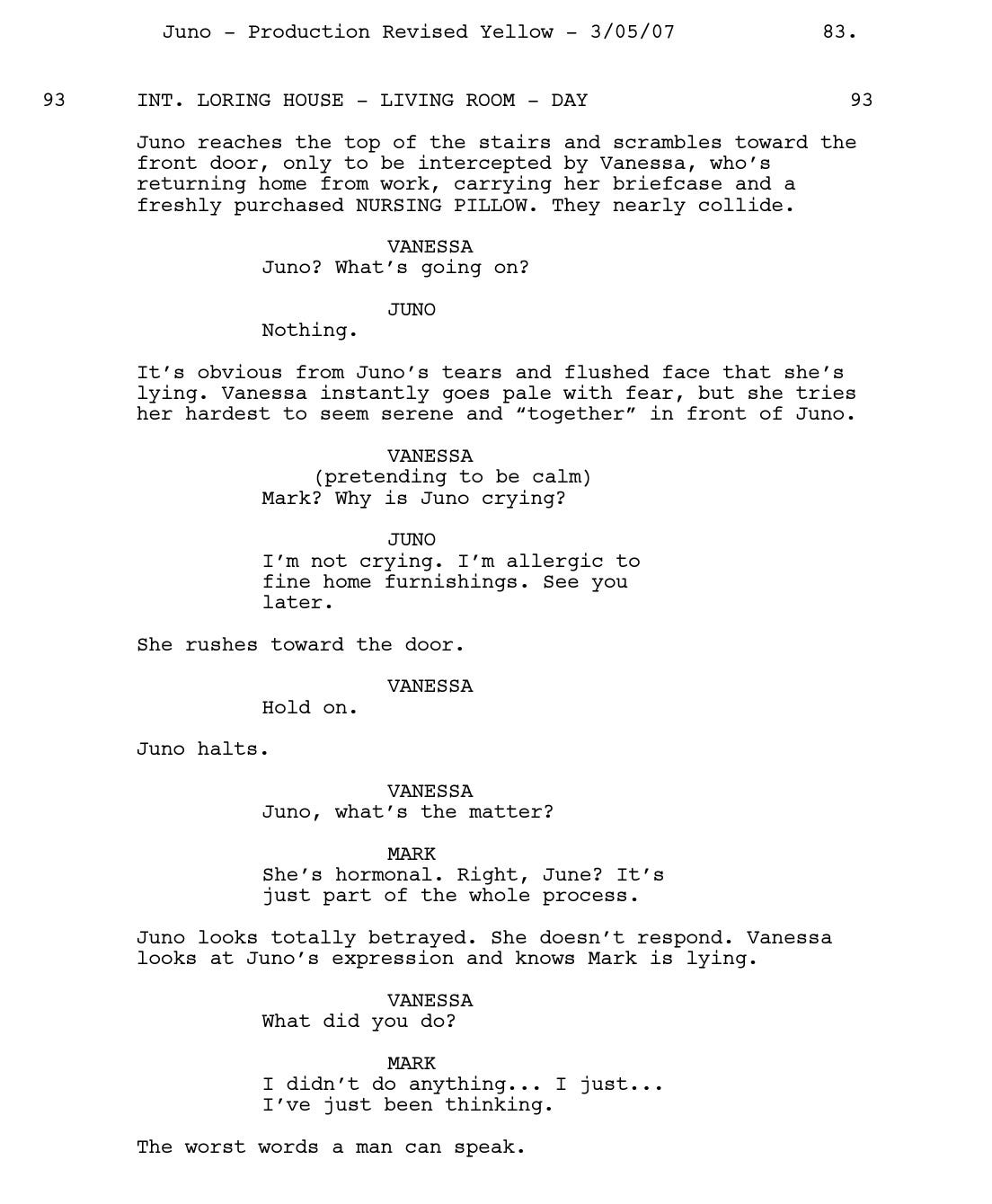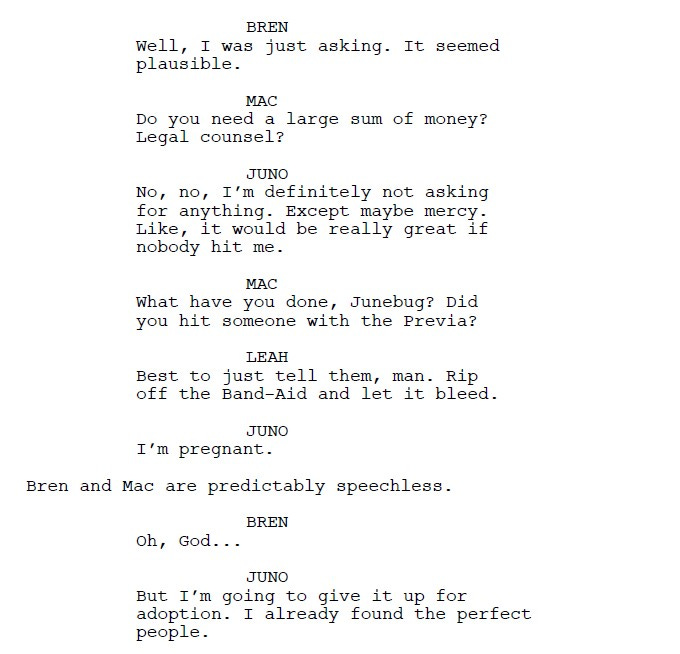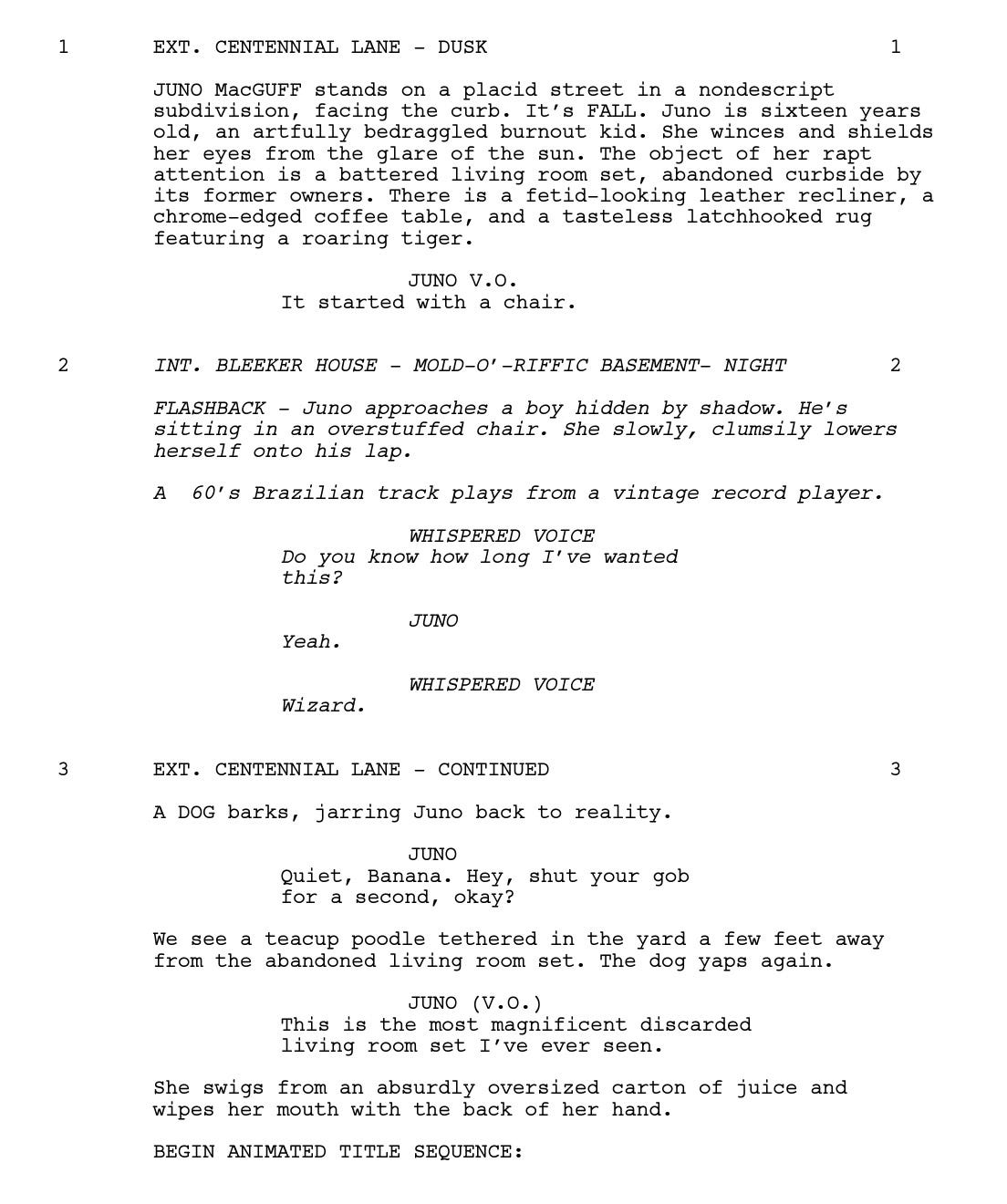Juno (2007) Script Review | #24 WGA 101 Greatest Scripts of the 21st Century
Quirky, funny, sincere, and lovely, Diablo Cody hit it big with her first feature screenplay dealing with a sensitive subject.
Logline: Faced with an unplanned pregnancy, an offbeat young girl named Juno makes an unusual decision regarding the unborn child.
Written by: Diablo Cody
Pages: 101
Scenes: 121
By Diablo Cody’s own admission, Juno was never meant to see the light of day. This tale of a teenage girl who accidentally gets pregnant, decides to have the baby, and give it up for adoption, was written as a script sample; its stylized witty dialogue and quirky personalities was a ‘Trojan horse’ to get it read. The fact that it found its way to the screen is a miracle, and one for which we are eternally grateful.
Juno MacGuff is not a typical teenager. She’s a bit of a burnout kid and a nerd; a lover of horror movies, punk rock, and a detached snarky attitude. One night, she has sex with her best friend, Paulie Bleeker. When she finds out that she’s pregnant, her first instinct is to get an abortion; but waiting at the clinic, Juno freaks out and decides to go through with the pregnancy instead.
This leads cleanly into Act 2, where Juno meets Mark and Vanessa Loring, the wealthy suburban couple adopting her baby. Vanessa yearns to be a mother; Mark is on the fence. See, Mark used to play in a band, but now he makes a (substantial) living as a composer for commercials. Juno, who also plays the guitar, clicks with Mark over their interest in music and horror, though their connection teeters dangerously close to troubled waters. But Mark has never stopped yearning to be a rock star; one of his frustrations is that he feels as if his real life is stuffed into boxes and a small room for his music equipment. It’s at this point that it becomes clear: Juno is really two stories, one about a 16-year-old girl who grows up too fast, and another about a 30-year-old man who refuses to grow up.
For despite her seeming maturity and worldliness, Juno is still a kid. Having grown up in the shadow of her mother’s abandonment, she wants her baby to be raised in a stable household and thinks the Lorings are it. When she learns that Mark wants to get a divorce, reality hits her hard. The scene where she pleads with Mark not to go through with it captures Juno’s dilemma of being trapped between the world of adolescence and adulthood. It’s a painful transition.
That’s one of the many beautiful things about this screenplay. Cody has created a character that acts and thinks like a real teenager, even with the unusual way she talks. Although Juno feigns nonchalance, the façade slips on many occasions to reveal her insecurities and vulnerabilities; a lot of them happens around Bleeker, the only person- except maybe her other best friend, Leah- she can be herself around.
It makes you wonder: Had Cody written Juno with the deliberate intention of getting it made, might the script have disappeared into oblivion? Worried about putting off financiers, would she have removed the very things that make the screenplay memorable? Nobody talks in real-life the same way that the characters in Juno do, but it is so wonderfully unusual and poetic that it’s integral to the DNA.
At the same time, when it chooses to get sincere and real, those moments hit with all the power of a right-cross, as in the conversation between Juno and her father, Mac MacGuff, about how you know when you’ve found someone worth keeping.
It’s also just plain funny! Cody has a gift for mining comedy out of the unlikeliest of situations, both in the story itself…
… as well as in the writing.
Other moments include Juno breaking the news of her pregnancy to her parents1…
… the visibly contrasting social gulf between the blue-collar MacGuffs and upper-class affluent Lorings…
… and pretty much any scene with Brenda, who gets some memorable lines to boot.
To ensure that readers know right off the bat what they are about to experience, Cody establishes what to expect with a killer opening page. It is an absolute doozy, establishing the tone, the inciting incident (the actual sexual encounter happened before the story begins and is shown in a brief flashback), the style and tone, and even the boldness—who’d think to turn a walk down a street into an animated title sequence?
The other bits of magic include Cody’s specific descriptions of items, such as the pregnancy test and the hamburger phone. Does the story need them? Not really. But what they do is create a heightened sense of reality; in some ways, it is not dissimilar to the tone found in the script Amélie.
Example of the pregnancy test:
Cody’s path to writing Juno is as fascinating as the script she penned— prior to this, she had no formal training as a screenwriter. Mason Novick, her future manager, stumbled across her work in the parody blog, Red Secretary (circa 2001-2004)— recounting amusing yet fictitious anecdotes about life as a secretary in Belarus— and an adult blog called The Pussy Ranch about working as a full-time stripper. Sensing her potential, he reached out and signed her up as a client. After a book deal, he urged her to write a script sample that he could use to pitch her as a screenwriter. To get an idea of how to write a screenplay, Cody read the scripts of films such as Ghost World and American Beauty. The first draft of Juno was written during lunch breaks when she temped, typing on a laptop at a Starbucks located in a Suburban Crystal’s Target in Minnesota. It took her one month to complete the draft, sometime around 2005. (In spite of detesting outlines, she discovered that doing a beat sheet halfway through writing made the process a whole lot easier). The eventual shooting script, Cody said, would be “virtually untouched from her original version.” For a first-time screenwriter, that never happens.
Juno is a wonderful gem of a screenplay, which is why it’s sad to hear Cody admit that she would not have written it after the United States Supreme Court overturned Roe v. Wade in 2022, an overruling that would have made it impossible or even illegal for women to secure an abortion. Had Juno been set more than 15 years later, it would have rung false; Juno MacGuff would never have been able to choose to keep the baby— the ability to pick is what makes a difference. In a move that is unsurprising, some in the ‘anti-abortion’ movement claimed Juno for their own—never mind that it was never about abortion at all. But with access to safe abortion closed off to many women in America, it’s hard to imagine this story set in any other time except the time it was written in.
Like many first-time writers, Cody drew inspiration from her own life. Juno’s predicament was influenced by a high school friend in Lemont, Illinois, who got pregnant as a teenager; the character was based on Cody herself. The hamburger-shaped phone in Juno’s bedroom was a type of phone that Cody had growing up.
The Juno screenplay can be broken down into three Acts.
Act 1: We meet Juno, Bleeker, Leah, and Juno’s father, Mac, and her stepmother, Brenda; Juno decides not to go through with getting an abortion, finds a couple to give up the baby for adoption, and tells her parents; (pages 1-30)
Act 2: We meet Mark and Vanessa Loring; Juno and Mark bond, as Juno’s pregnancy advances across the remainder of the course; it ends with Juno discovering that Mark wants to divorce Vanessa, devastating her; (pages 31-87)
Act 3: The last leg of the story covers Juno recognizing Bleeker as special, and admitting her feelings for him; the birth; Vanessa getting to be a mother at last, and Juno sometime after the pregnancy. (pages 88-101)
Ultimately, the fates favored Juno. In a blisteringly competitive year for movies, it won the Academy Award for Best Original Screenplay, beating out Lars and the Real Girl, Ratatouille, and Michael Clayton, all of which made the cut for the WGA’s 101 Greatest Screenplays of the 21st Century. Cody broke through by creating compelling and memorable characters and furnishing them with quirky dialogue to tell a story that she was not seeing being made at the time. If it worked for her, who knows? It might do the same for you.
Notes:
AP (January 5, 2008) | From saucy to sweet (The Age)
Chang, Bea (February 25, 2008) | Diablo Cody's Minnesota connections (Kare 11)
Hiscock, John (February 2, 2008) | Diablo Cody: 'I feel more naked writing than I did as a stripper' (The Telegraph)
Dibdin, Emma (February 7, 2008) | Labour Day: Behind the scenes on Juno (The Cambridge Student)
Brown, Evan Nicole (July 15, 2022) | Diablo Cody Meditates on ‘Juno’ and Its Critics 15 Years Later: “I Am Emphatically Pro-Choice” (The Hollywood Reporter)
Fang, Marina (May 16, 2019) | Diablo Cody Says She Wouldn't Have Written 'Juno' In Today's 'Hellish Alternate Reality' (HuffPost)
Gutin, Zack (April 24, 2015) | ‘This is for the Writers!’ A Conversation with Diablo Cody (The Script Lab)
Marotta, Jenna (April 9, 2017) | Diablo Cody Sets the Record Straight on Juno (Vanity Fair)
Gervich, Chad (June 24, 2008) | The WD Interview: Diablo Cody (Writer’s Digest)
The scene was inspired by Cody’s memory of telling her parents that she landed a book deal based on her blog… about making her living as a stripper.
















